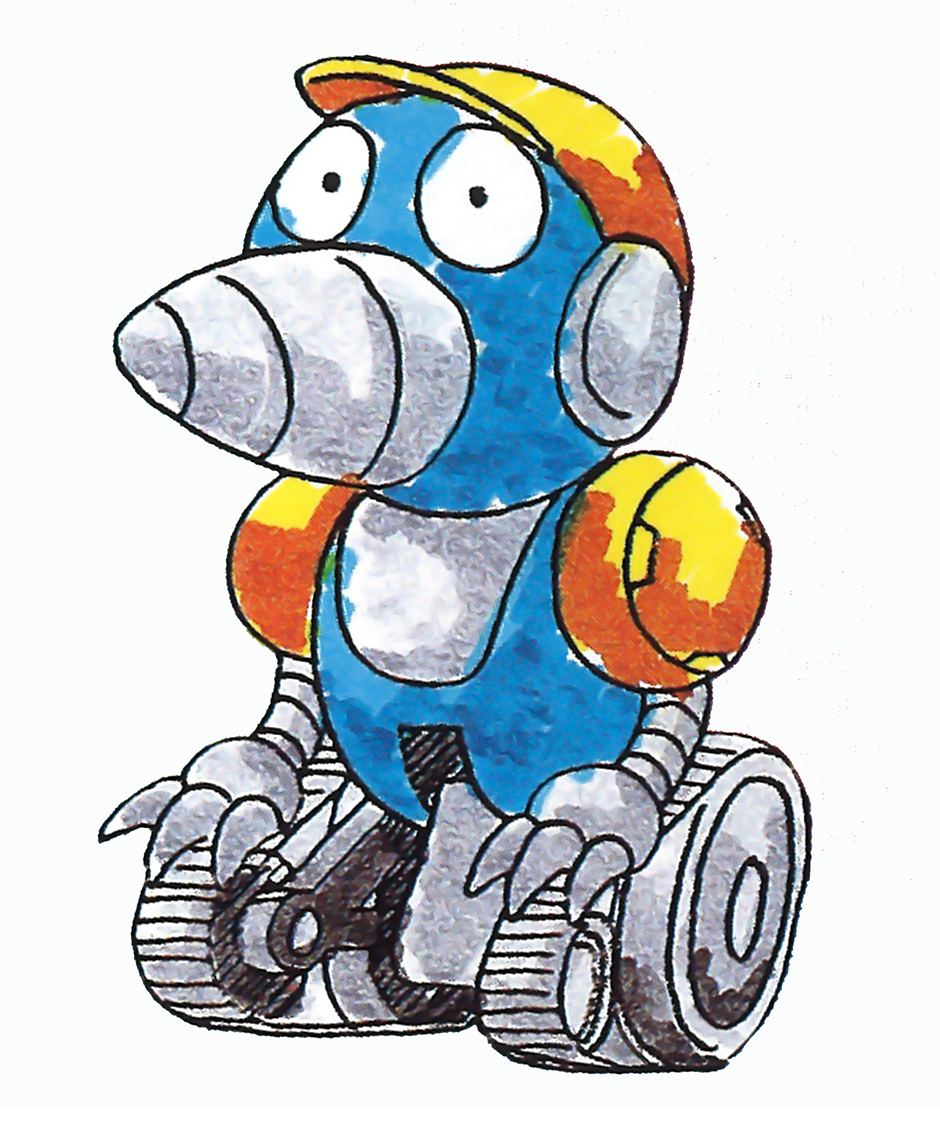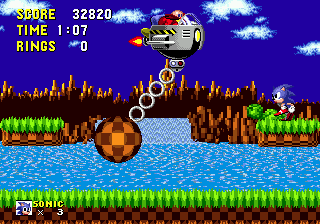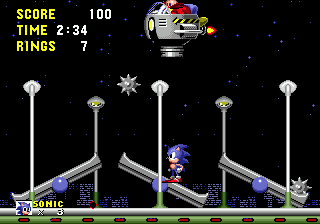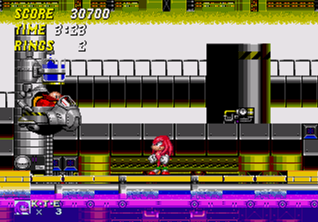Sorry about yesterday's missed update; I had a personal issue that needed my full attention. Today, I'll bring you two updates to catch us back up. As for now, I continue where I left off: the second half of the level themes.
5) Miscellaneous Environments
Competing Zones: Star Light, Hilltop, Mystic Cave, Ice Cap, Sandopolis, Lava Reef
In Part I, we covered the basic zone types in Sonic. This category contains various environmental territory that doesn't fall into other categories.
Star Light Zone is an oft-forgotten zone from the original game that is highly underrated. This zone showcased some serious speed, with plenty of loops and straightaways all within a city-at-night environment. There were more bottomless pits in this stage than anywhere else in the original game, as many of the platforming sections were suspended over nothing, making this both fun and treacherous. The music gives you a laid back feeling that is much deserved coming out of Labyrinth and into Scrap Brain.
Hilltop is reminiscent of Green Hill and Emerald Hill zone with the same kind of stylization, but featured high above the clouds on top of a mountain. Oh yeah, and there's caves, lava, earthquakes and robotic dinosaurs!? A fun level with plenty moments of panic for when Sonic gets stuck in a cave-in. Aside from those parts where you feel rushed, this was a pretty slow stage, with most of the puzzles being vertical. Overall, not too shabby, but it could have been improved.
Mystic Cave was a dazzling stage with plenty of danger: dark backgrounds and hidden enemies, not to mention spikes galore. Add a funky bassline and you've got the makings of a good stage. It does lose points for having the "Super Sonic pit" filled with spikes and no way of escape, leaving you to wait till the rings run out before you have another shot. This one sort of reminded me of Labyrinth: difficult and cramped, but Mystic Cave didn't have those #&^$ Grounders!
Ice Cap was an interesting level, the first one featuring ice at all. It certainly had its moments, but it was far too short compared to the three stages that came before it. It certainly started out with a bang as Sonic began his snowboarding career, something he would continue in both
Sonic Adventure games. Getting frozen was pretty annoying, though.
Sandopolis was looooooong and dreary. It really felt like a desert and I've got to give Sonic Team credit for that, but it certainly isn't the most fun stage to play. It featured an interesting mini-boss in that Rock Golem thing. Then the scene switches to the pyramid. And you though the desert part was bad? How about a quickly dimming burial chamber with unfriendly ghosts? More timer puzzles and don't even get me started on the sand. The sooner you get out of this one, the better.
Lava Reef was a welcome relief (rhyme, anyone?) Quite dangerous featuring lava everywhere (and giant spiked balls) and those weird gas-releasing pole badniks. A very dynamic level that features speed, falling, rock crushing and a few high-flying sections. Not to mention all the giant rings you can get your grubby little hands on, seeing as it was your last chance for Chaos Emeralds. A sharp dynamic change in the second Act when the volcano cools off, leaving you in the crystallized center that now features metal platforms, flamethrowers and rotating columns of spikes. That's not even counting the thrilling conclusion leading up to the boss fight!
I think Lava Reef is probably the best zone of this group, but I'm going to give it to the underdog in hopes that you'll go back and reevaluate it yourself.
Miscellaneous Environments: Star Light Zone
(Sonic the Hedgehog)
6) Eggman Holdings, Inc.
Competing Zones: Chemical Plant, Oil Ocean, Wing Fortress, Flying Battery
This category contains Eggman's facilities that are not his immediate base for the game (coming up soon!) Mechanical wastelands these are.
Chemical Plant gets a bad reputation. The second Act is surprisingly difficult for how early it is in the game. Honestly, it's really just that one part where you might drown, but it's a real testament to the franchise that once part of a level becomes so memorable. What baffles me though is why Mega Mack was introduced in
Sonic 2 before the water level. At least you can breath underwater if you find the bubbles! Nevertheless, Chemical Plant was a little too short, but featured some incredibly fast sections with giant loops and hills. It's a good follow-up to Emerald Hill, but as mentioned, forever lives in infamy.
Oil Ocean is a real pain in the butt. Quicksand-like oil under breaking platforms and weird balloon-launching sections. Entirely too slow and the orange sky makes sick. However, I can't look away from the screen lest one of those seahorses sneaks up on me!
Wing Fortress is a killer stage. Suspended high above the world, Sonic runs through, over and even under a giant war-craft. Finesse and an iron stomach are needed to successful complete this interesting level filled with turrets, conveyors and break-away panels (Knuckles can just glide over that part.) Fortunately, the game gives you a break by only populating this stage with one not-too-difficult badnik: a chicken in a tank?
Flying Battery is pretty much a revamped version of Wing Fortress, but with a whole lot more indoor monotony. How big can this thing be!? I guess it was only a matter of time before Eggman rigged those Egg prisons with traps instead of furry animals... . While it was stylistic different from Wing Fortress, Flying Battery could not emulate the feeling that the former gave you.
Eggman Holdings, Inc.: Wing Fortress
(Sonic 2)
7) Interludes
Competing Zones: Sky Chase, Hidden Palace (Sonic),
Hidden Palace (Knuckles)
The little levels that tell more story than provide action. You'll notice I counted both versions of Hidden Palace as separate entities. Knuckles' five-second zone had its appeal, too!
Sky Chase Zone is unique. Sonic's floating lazily on a bi-plane with nothing but a huge force of badniks coming at him. Oh, and he can't spindash or he'll fall 30,000 feet to his death. Oops! It's about a minute and a half long, and previews Wing Fortress Zone in a cool cinematic event.
Sonic's Hidden Palace did a lot for video games. It showed that you don't need characters to talk (or even emote a whole lot) to tell a story. Some sweet backgrounds (even an ancient prophecy?) relieve the eye as you fight Knuckles, watch Eggman hijack the Master Emerald and make a new friend! The fight with Knuckles isn't that great, but it was such a relief after spending the whole
Sonic 3 & Knuckles game getting duped, tricked and misguided by the echidna bastard. The cinematics were great considering when this game came out and left a lasting imprint in my mind.
Knuckles' Hidden Palace was five seconds and you're out. What's the big deal? It's the mystery! Why did they include this? I want to see more! It's so appealing, but you're immediately whisked away into the boss fight. Oh well.
Interlude: Hidden Palace Zone
(Sonic & Knuckles, Sonic's version)
8) Eggman's Base
Competing Zones: Scrap Brain, Metropolis, Launch Base, Death Egg (Sonic & Knuckles)
What we've all been waiting for, right? These end-game levels offer the most difficulty you're going to get out a regular zone. Eggman hides away here with some of his best badniks.
Scrap Brain was excellently done. To say it was perilous is an understatement. Flames, suddenly-dropping floors, more opportunities to get crushed than you can shake a stick at and pigs are bombing you from above. Surprisingly dynamic for the original game, this zone changes for each act, including a short cinematic as Sonic gets dropped into a suspicious palette-swap of Labyrinth Zone, featuring Mega Mack's first appearance. This may well be the crown jewel of the original game.
It's hard to beat Metropolis Zone. Excellent level-design featuring a mechanical theme filled with gears, screws, pipes and steam. And, oh yeah, lava. A bad-ass team of badniks patrol the area, firing at Sonic like mad. The longest stage in
Sonic 2, coming in at three Acts full of original material, including a signature boss fight, perhaps the second-most referenced in the series.
Launch Base zone wasn't as thrilling as it could've been. It was dangerous, sure, but there wasn't much that was particularly memorable about it. Seeing as
Sonic 3 & Knuckles is supposed to be one full game, this felt too much like a hasty semi-climax rather than a full finish.
The Death Egg Zone from
Sonic & Knuckles was a thing of beauty: gravity-defying antics, laser-guided travel and some serious lightning. This level was difficult, but sincerely rewarding. After
Sonic 2, it was nice to finally explore the Death Egg rather than just exchange blows in it. A very deep and detailed level, Sonic Team wasted no effort on this one.
Death Egg Zone was brilliant, but I'm giving second place by a hair.
Eggman's Base: Metropolis Zone
(Sonic 2)
9) Boss Zones
Competing Zones: Final, Death Egg (Sonic 2)
, Doomsday
...and that's the end, right? Hooooooold on a second, slim! There's some serious fighting left to be done! There's not much to say about these zones as I'll be discussing Eggman's machines in the next installment, so this is more of a psychological thing.
Final Zone was the expected climax of the original game. You spring out of Scrap Brain, leaving you with one boss to fight. Appropriately named, but not particularly thrilling.
Sonic 2's Death Egg was brutal. Two very hard bosses back-to-back with no rings. Incredibly daunting and features some excellent music, though most of us never got passed the first 10 seconds before the boss themes kicked in, right?
Doomsday Zone had a certain kick to it. It was hidden and a total surprise. It looks like everything's wrapped up nicely, you destroy Eggman's robot and he takes heavy damage trying to escape as the Death Egg crumbles around you. Does Sonic tumble down from space with the emerald? No! He blasts off after a fleeing Eggman as Super Sonic, hurtling through space at ridiculous speeds, risking every fiber of his being to secure the Floating Island's future! An incredible finish to the Genesis generation Sonic games. Did you expect anything less?
Boss Zones: The Doomsday Zone
(Sonic & Knuckles)
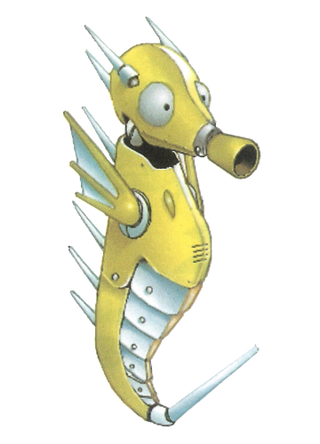 Here's a real pain in the butt if there ever was one. Aquis floats freely along Oil Ocean Zone's various platforms, shooting projectiles from its snout. While not particularly dangerous per se, this seahorse has a trick up his non-existent sleeve. Most badniks can easily be bypassed by running forward, however, Aquis follows Sonic throughout the level, even up to entirely different floors. Couple that with a traumatic experience from my childhood with one of these and you've got a real crippling badnik.
Here's a real pain in the butt if there ever was one. Aquis floats freely along Oil Ocean Zone's various platforms, shooting projectiles from its snout. While not particularly dangerous per se, this seahorse has a trick up his non-existent sleeve. Most badniks can easily be bypassed by running forward, however, Aquis follows Sonic throughout the level, even up to entirely different floors. Couple that with a traumatic experience from my childhood with one of these and you've got a real crippling badnik. 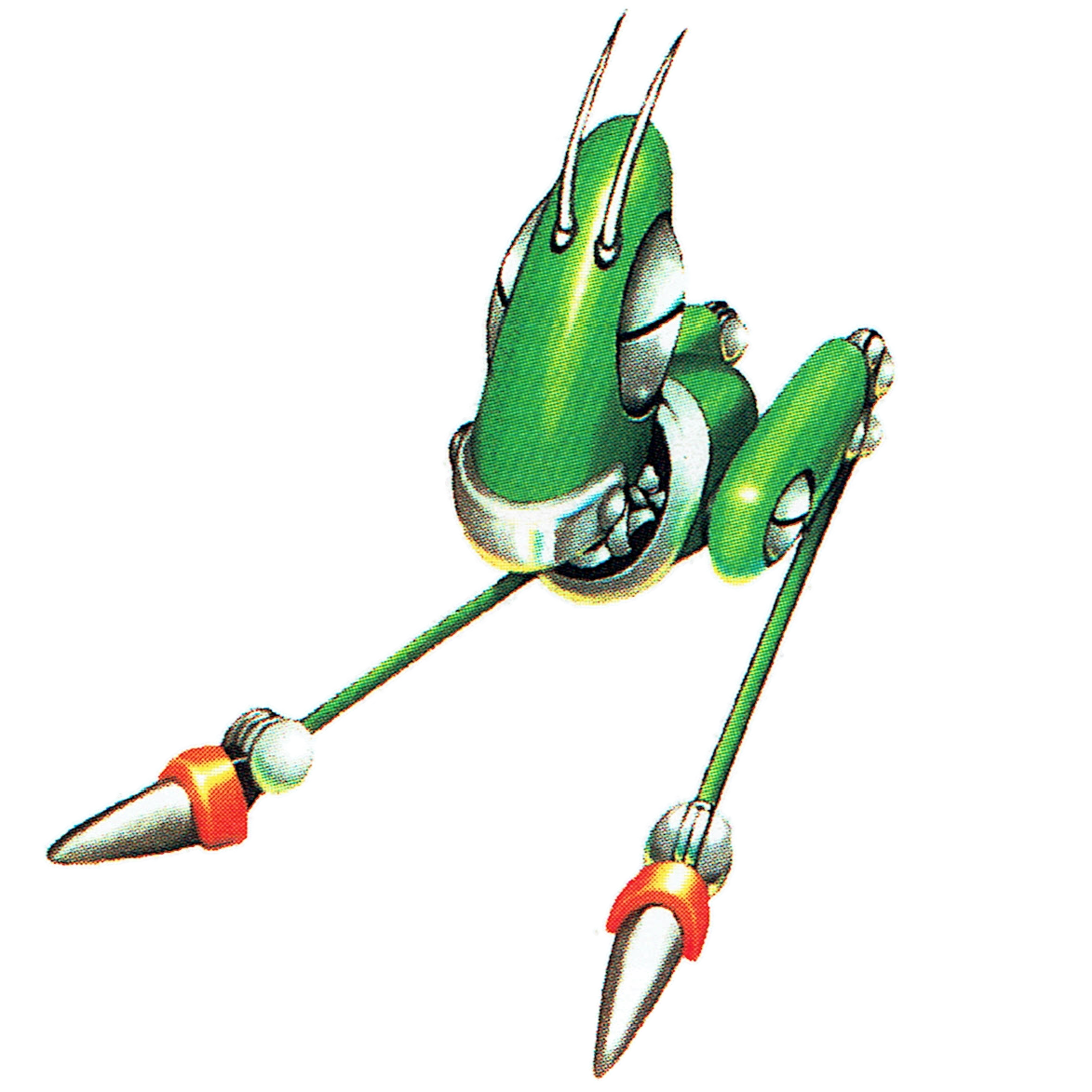 Beginning the top half of this list is the most annoying bot of all: Mantis. Hiding in the grass of Marble Garden Zone, Mantis jumps straight up. Mostly appearing in speed-based areas, he usually jumps over Sonic harmlessly (making him particularly hard to destroy.) However, occassionally he will not clear our hedgehog hero, stealthily sapping Sonic's rings. He's surprisingly evasive when you turn around to kill him out of spite. Mantis really makes the blood boil.
Beginning the top half of this list is the most annoying bot of all: Mantis. Hiding in the grass of Marble Garden Zone, Mantis jumps straight up. Mostly appearing in speed-based areas, he usually jumps over Sonic harmlessly (making him particularly hard to destroy.) However, occassionally he will not clear our hedgehog hero, stealthily sapping Sonic's rings. He's surprisingly evasive when you turn around to kill him out of spite. Mantis really makes the blood boil.
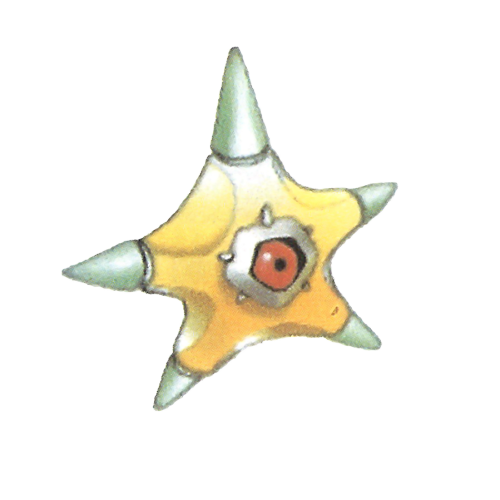
 Some of you may be upset that I did not pick a definitive number one for this list. Fear not! Should I have separated this 'dream team,' all still would have appeared on this list, but one stands out the most dangerous badnik: Slicer (the mantis) is a deadly ninja. He wanders the floors (and ceilings!) of Metropolis, tossing his claws the second Sonic gets near. While the claw-tossing leaves him helpless, avoid these angling projectiles is far from easy. To have a realistic chance of surviving, Sonic must literally predict his appearance, stop and slowly approach the mantis to lure him into throwing the claws at a safe distance. Approaching this badnik at even a jog spells certain doom for our hero!
Some of you may be upset that I did not pick a definitive number one for this list. Fear not! Should I have separated this 'dream team,' all still would have appeared on this list, but one stands out the most dangerous badnik: Slicer (the mantis) is a deadly ninja. He wanders the floors (and ceilings!) of Metropolis, tossing his claws the second Sonic gets near. While the claw-tossing leaves him helpless, avoid these angling projectiles is far from easy. To have a realistic chance of surviving, Sonic must literally predict his appearance, stop and slowly approach the mantis to lure him into throwing the claws at a safe distance. Approaching this badnik at even a jog spells certain doom for our hero! 




